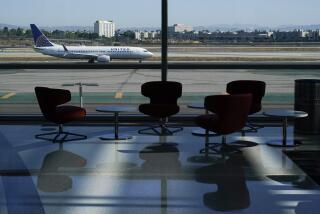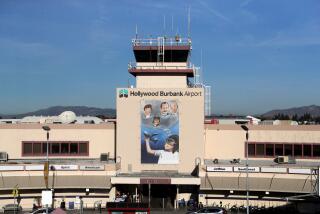FAA Wonât Provide Parking Funds : Replacing Spaces Could Cost $11 Million, Official Warns
The Federal Aviation Administration has refused to provide federal money to help the Burbank airport replace financially vital parking spaces that airport authorities are eliminating to meet FAA safety directives.
The FAA refusal was discussed at a meeting of the Burbank-Glendale-Pasadena Airport Authority, with one commissioner warning that the authority may have to spend as much as $11 million to build replacement automobile parking.
The 450 auto parking spaces east of the main terminal building will be converted later this into a jetliner boarding area that will make it possible to move parked planes farther from the east-west runway.
Estimate of $6 Million
Commissioner Carl Mesek told the other members of the airport authority that preliminary discussions with engineers and architects raised the possibility that building a parking structure to replace the lost parking area could cost more than the $6 million originally expected.
âMaybe itâs closer to $10 million or $11 million,â Mesek said.
The FAA told the airport authority in a letter that the parking structure would not be eligible for federal construction funds, but that money may be available for construction of the boarding area. No cost estimate was given for the conversion.
Parking Produces Income
Money from parking fees is the airportâs single largest source of income, bringing in almost $4.3 million of the authorityâs $11 million in revenue last fiscal year.
Airport administrators cautioned that the cost estimates for a new parking structure are preliminary, and that the airport authorityâs engineering and architectural firms will be working to come up with firm estimates for several alternatives.
Those alternatives and the methods of financing them probably will be presented to the airport authority at its first meeting in June, said Tom Greer, director of airport services.
Among the options that will be considered are the purchase of land away from the airport for a remote parking lot and the construction of a parking structure that is partly underground, Greer said.
The advantage to building underground parking is that it might be allowed to remain in place when the airport authority builds a new terminal. The airport authority has been under a longstanding FAA order to replace the 56-year-old terminal because it is closer to the runways than FAA regulations allow.
Authority members fearful that, if they build a new parking structure east of the existing one, it, too, may have to be razed when the new terminal is built.
If the parking structure were partly underground, it could be kept below FAA height limits on buildings near runways, allowing it to remain in place after another terminal is built, Greer said.
More to Read
Sign up for Essential California
The most important California stories and recommendations in your inbox every morning.
You may occasionally receive promotional content from the Los Angeles Times.











